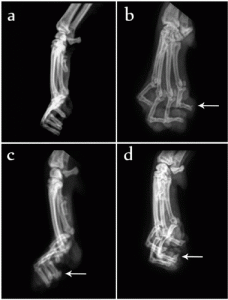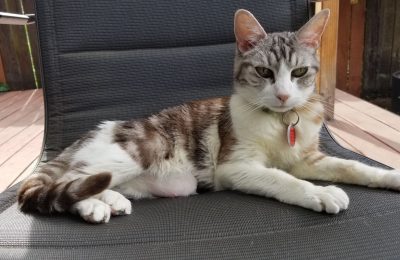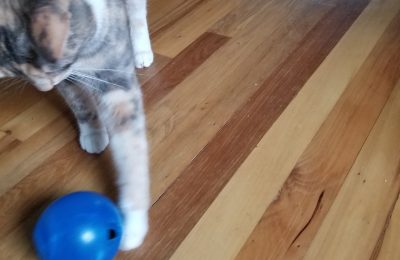If there’s a veterinary “procedure” that tends to gets people all wiggly, it might be the declawing of domestic cats. Declawing is the amputation of a cat’s toes (with scalpel, laser, or even with claw clippers), usually performed to prevent furniture scratching.
“It saves lives,” “it keeps cats out of shelters,” “banning medical procedures is a slippery slope…” we’ve heard it all. Those of us who work professionally with cats have also seen repercussions – the declawed cats surrendered to shelters with behavior issues, the cats who have been hobbled with arthritis from years of walking unnaturally, cats who can no longer engage in natural behaviors like scratching and stretching.
People get up in arms easily over tail and ear docking of dogs, but it feels like declawing is still treated like a fringe issue. I’ll be upfront with you. I don’t think declawing is necessary EVER, I don’t think it’s a humane choice, and honestly, I feel like if you can’t live with a cat with their claws, you shouldn’t have a cat as a companion animal. So now that I’ve gotten that out of the way – let’s talk about some new research that provides strong evidence for the negative effects of declawing.
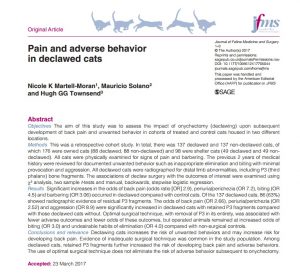 In a study just released in the Journal of Feline Medicine and Surgery, “Pain and adverse behavior in declawed cats,” researchers studied 137 declawed cats, with a control group of 137 paw-intact cats matched for age. Each cat was given a physical exam, including a common test for back pain, by palpating areas of the spine and noting reactions. As cats are digitigrade, or walk on their toes, removing their toes changes their posture, which is hypothesized to cause long-term physical effects, including the risk of arthritis.
In a study just released in the Journal of Feline Medicine and Surgery, “Pain and adverse behavior in declawed cats,” researchers studied 137 declawed cats, with a control group of 137 paw-intact cats matched for age. Each cat was given a physical exam, including a common test for back pain, by palpating areas of the spine and noting reactions. As cats are digitigrade, or walk on their toes, removing their toes changes their posture, which is hypothesized to cause long-term physical effects, including the risk of arthritis.
All declawed paws were x-rayed, and a behavioral history was taken on each cat. In addition to determining if there was an association between declawing and behavioral issues or pain, the investigators were interested in whether there were any fragments of the removed bone, or phalanx (P3), left behind.
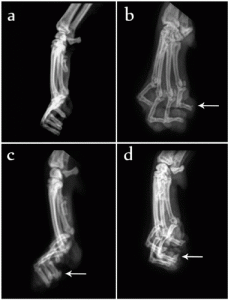
P3 remnants can be problematic, because these fragments and the possibility of “bony regrowth” (where the claw continues growing from the bone) can cause a “pebble in the shoe” sensation. The veterinary textbook, “Complications in Small Animal Surgery,” recommends removal of any P3 fragments because of associated pain and lameness.
In the current study, examination of x-rays revealed that 63% of declawed cats had P3 fragments left behind. This means the declaw surgery did not remove the entire bone as intended. Four cats also had visible nail re-growth that had not been noticed by their owner.
To quantify the relationship between declawing and back pain, elimination outside the litter box, and aggression, the experimenters reported odds ratios. This statistic is a way to express how strongly one property (such as back pain) is associated with another property (such as being declawed).
Analyses showed that declawed cats had stronger associations with back pain (odds ratio(OR): 2.9, meaning that declawed cats were 2.9 times more likely to have back pain than intact cats); elimination outside the litter box (OR: 7.2), biting (OR: 4.21), aggression (OR: 3), and overgrooming (OR: 3.06). The ratios when comparing cats with P3 fragments to those who did not and the control group were even higher. Translation: declawed cats were more likely to experience all negative outcomes, and this effect was even stronger in the 63% of cats with P3 fragments.
Looking at this in raw numbers, 56 declawed cats exhibited elimination outside the litter box compared to 12 non-declawed cats. Thirty-nine declawed cats had signs of back pain compared to 17 non-declawed cats; 33 declawed cats had a history of biting, compared to 9 of the non-declawed cats.
This study provides strong evidence that declawing is associated with adverse outcomes for domestic cats. The large sample size and matched controls, as well as the inclusion of radiographs and a physical exam are a significant improvement on previous studies. The quantification of aggression (based on reports from owner, or behavior that occurred during the veterinary exam) is perhaps the least reliable, and it would be great to have more detail on the types of aggressive behavior exhibited, since they were all lumped together.
The fact that 63% of declawed cats had P3 fragments left behind suggests that the declaw surgery, when performed, is not performed “well.” (if such a thing can be said). The authors suggest this “reflects the use of poor or inappropriate surgical techniques,” which increases the chance of negative outcomes for declawed cats.
Previous studies have not been a slam dunk for showing that declawing is associated with long-term ramifications. These studies have often had small sample sizes, and none have previously used radiographs to examine the physical changes related to declawing. A 2005 study showed that cats who had undergone declawing or tenectomy (severing of the tendons to prevent flexing them to scratch) experienced more pain that control cats who received a sham surgery. Declawed cats are also at risk for phantom pain or neuropathic pain that can last their lifetime if untreated.
The current study has the potential to force the veterinary industry to rethink whether declawing should still be considered part of the veterinary oath of “protection of animal health and welfare…the prevention and relief of animal suffering.”
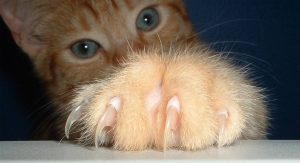
Even if declawed cats did not experience more behavior problems than intact cats, I would call it unjustifiable due to the fact that the procedure deprives cats of expressing natural behaviors and changes how cats walk. The American Veterinary Medical Association has opposed the declawing of exotic cats due to adverse effects. Perhaps the AVMA will step up and do the same for domestic cats now that we have evidence that declawing leads to pain, biting, and avoidance of the litter box (their stance is…much milder…and looks like they might have to update that statement “There is no scientific evidence that declawing leads to behavioral abnormalities when the behavior of declawed cats is compared with that of cats in control groups.”). To compare, the Canadian Veterinary Medical Association stated its opposition to declawing earlier this year (“It offers no advantage to the feline”).
What is the biggest challenge? Cat owners who choose to declaw their cats are often quite satisfied with the results. Given that cats are known for hiding pain, and that cat owners are terrible at recognizing signs of pain (as I recently wrote about), and that not all cats show negative behavioral repercussions, I’m sure many people are saying…”my cat was declawed and turned out just fine.” But declawing is permanent, and represents a gamble – that a declawed cat won’t experience an adverse outcome.
I hope this study will lay the groundwork for the eradication of this unnecessary, painful, and harmful procedure. Knowing what we now know, can we justify the risks of harming cats because we don’t want to train them to use a scratching post?
Reference: Nicole K Martell-Moran, N.K., Solano, M., & Townsend, H. G. (2017). Pain and adverse behavior in declawed cats. Journal of Feline Medicine and Surgery. 10.1177/1098612X17705044

